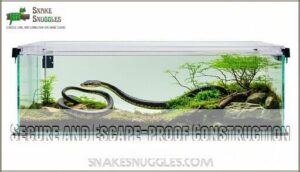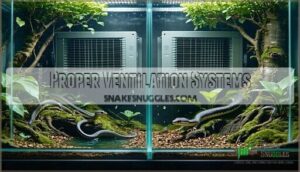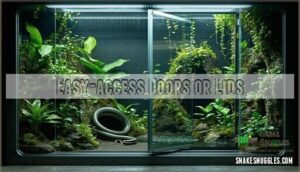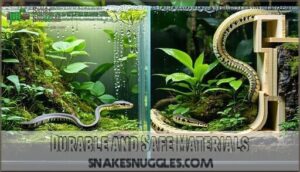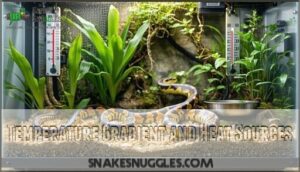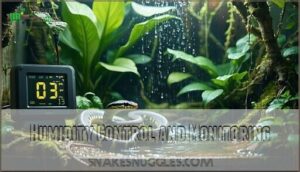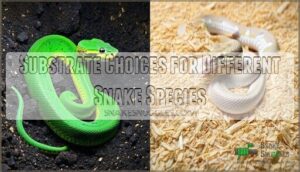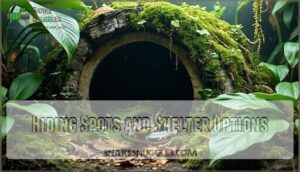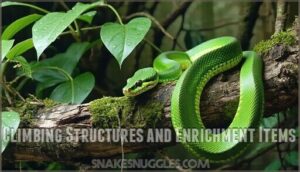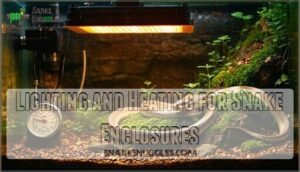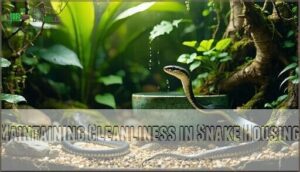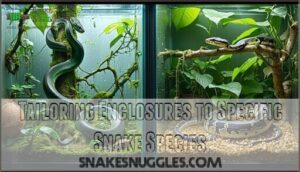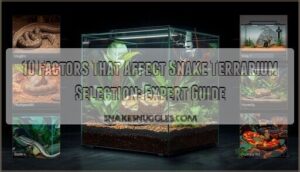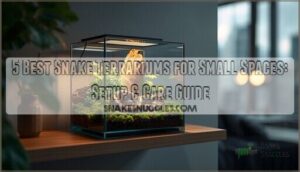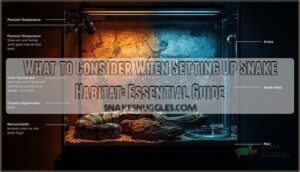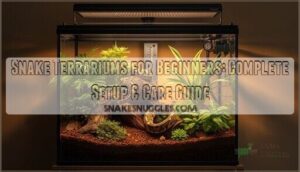This site is supported by our readers. We may earn a commission, at no cost to you, if you purchase through links.
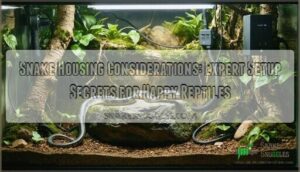
Create a temperature gradient from 78-88°F with a basking spot, maintain proper humidity levels, and choose appropriate substrate.
Include hiding spots on both warm and cool sides, plus a water dish. Don’t forget climbing branches for arboreal species or deeper substrate for burrowers.
Your heating system needs a reliable thermostat – trust me, your snake won’t appreciate temperature swings any more than you’d enjoy a broken air conditioner. Getting these fundamentals right sets the stage for some game-changing setup tricks that’ll transform your snake’s world.
Table Of Contents
- Key Takeaways
- Essential Components of a Snake Enclosure
- Creating The Ideal Snake Habitat Environment
- Lighting and Heating for Snake Enclosures
- Maintaining Cleanliness in Snake Housing
- Tailoring Enclosures to Specific Snake Species
- Frequently Asked Questions (FAQs)
- What should I consider before bringing a snake into my home?
- How to choose a snake enclosure?
- What happens if a snake enclosure is too small?
- How do you care for a snake’s enclosure?
- Do snake cages need to be ventilated?
- How do I choose a snake habitat?
- What are the requirements for a snake habitat?
- What should a snake enclosure have?
- What is the best accommodation for a snake?
- How often should I upgrade my snakes enclosure size?
- Conclusion
Key Takeaways
- Size your enclosure properly – You’ll need an enclosure that is at least equal to your snake’s adult length, not its current size, with appropriate height for arboreal species or width for ground-dwellers.
- Create proper temperature gradients – You must establish a basking spot at 88-95°F and a cooler side at 78-85°F, using reliable thermostats to prevent dangerous temperature swings that stress your snake.
- Ensure escape-proof construction – You’ll need secure locks, sealed edges, and sturdy materials like thick glass or PVC, since snakes exploit any weakness to escape their enclosures.
- Maintain species-specific humidity levels – You should provide 50-70% humidity for most species, using proper ventilation, substrate choice, and water placement to prevent shedding issues and respiratory infections.
Essential Components of a Snake Enclosure
You’ll need five critical components to build a snake enclosure that keeps your scaly friend secure and comfortable.
Getting these basics right from the start prevents costly mistakes and guarantees your snake thrives in its new home, ensuring it is secure.
Appropriate Enclosure Size and Shape
The right snake enclosure size makes all the difference between a stressed serpent and a content crawler.
When planning your snake’s home, measure their adult size – not their current length. A snake length measurement helps determine if you need vertical vs horizontal space.
Arboreal species love tall enclosures, while ground-dwellers prefer width. Use a space calculator to nail perfect species dimensions for your scaly friend’s forever home.
Secure and Escape-proof Construction
Building an escapeproof snake enclosure requires attention to detail that’d make Houdini jealous.
These slithery escape artists exploit any weakness in your setup.
- Select sturdy materials like thick glass, PVC panels, or sealed wood that won’t warp over time.
- Seal all edges with aquarium-grade silicone, eliminating gaps where snakes might squeeze through.
- Install robust locking mechanisms on lids and doors for both escape prevention and childproofing enclosures.
- Inspect construction regularly for wear, checking corners and joints where structural failure typically occurs.
Proper Ventilation Systems
Your snake’s ventilation systems create healthy airflow design that prevents disaster.
Strategic mesh types like aluminum or plastic screens maintain proper air quality while controlling humidity balance.
Good snake habitat ventilation stops mold prevention nightmares and handles odor control like a champ.
Poor air purification leads to respiratory infections faster than you’d expect.
Position vents on opposite sides for cross-ventilation magic.
Easy-access Doors or Lids
Easy access transforms routine snake housing maintenance from wrestling match to smooth operation.
You’ll need latch mechanisms that balance security features with user-friendly operation.
Hinge durability matters – cheap hinges fail when you need them most.
Choose snake enclosure designs with wide openings for cleaning access.
Material transparency helps you monitor your snake without disturbing them.
Well-designed snake habitat easy access means quick feeding and snake enclosure setup adjustments without stress.
Durable and Safe Materials
Choose Glass vs. PVC wisely—glass offers crystal-clear viewing but PVC holds humidity better.
Non-toxic wood works too, but skip cedar or pine. Use aquarium-grade silicone as your safe sealant of choice.
Material strength matters since snakes are escape artists. Avoiding corrosion means ditching metal hardware.
Your snake enclosure materials should outlast your mortgage while keeping your scaly friend safe and sound. Consider HDPE for long-term durability and safety.
Creating The Ideal Snake Habitat Environment
You’ll create a thriving snake habitat by mastering six key environmental factors that directly impact your pet’s health and happiness.
Getting the temperature gradient, humidity levels, substrate choice, hiding spots, climbing structures, and water sources right means the difference between a stressed snake and a content one.
Temperature Gradient and Heat Sources
Your snake’s happiness depends on proper temperature zones. Think of it as creating a reptilian spa with different heat rooms. Your scaly friend needs options to self-regulate body temperature effectively.
Think of your snake’s enclosure as their personal temperature buffet – they’ll cruise between zones to find their perfect comfort spot.
Here’s your heat setup checklist:
- Basking spot design: Position at 88-95°F using quality heat lamps
- Temperature gradient monitoring tools: Digital thermometers on both ends
- Heat source safety: Guards prevent burns, thermostats prevent overheating
- Nighttime temperature drop: Cool things down 5-10°F naturally
Snake heating elements work best when you understand gradient monitoring. Consider consistent heat output for ideal reptile health. Your snake will cruise between zones like picking the perfect shower temperature.
Proper snake heating means avoiding hot rocks (they’re basically torture devices) and using under-tank heaters with thermostat calibration for consistent warmth.
Humidity Control and Monitoring
With proper temperatures set, humidity control becomes your next mission.
Digital hygrometers track moisture levels accurately – calibrate monthly for precision.
Most snakes need 50-70% humidity, but tropical species require higher levels.
Misting systems create humidity gradients naturally.
Poor humidity causes shedding issues and respiratory infections, so monitor daily and adjust water bowl placement near heat sources.
Many keepers purchase a digital reptile hygrometer for this purpose.
Substrate Choices for Different Snake Species
Your snake substrate choices can make or break their happiness.
Ball pythons thrive with coconut fiber for humidity retention, while corn snakes prefer aspen shavings for burrowing substrates.
Aspen vs. cypress depends on moisture needs—cypress suits tropical species, aspen works for arid ones.
Substrate depth matters: hognose snakes need 3-5 inches for digging.
Avoiding toxins like cedar is non-negotiable for safety.
For ball pythons, coconut husk substrate effectively reduces odors.
Hiding Spots and Shelter Options
Your snake craves secure hides like you crave your favorite blanket fort.
Place multiple hides in both warm and cool zones using naturalistic hides like cork bark or hollow logs.
Even a simple cardboard box works wonders.
Smart hide placement means your snake always has a cozy hiding spot nearby.
Think of it as snake real estate – location matters for those perfect snake hide boxes!
Climbing Structures and Enrichment Items
Enrichment transforms your snake’s enclosure from a basic cage into an engaging habitat. Climbing structures and enrichment activities provide essential behavioral enrichment that keeps snakes mentally stimulated and physically active.
Think of it as building a jungle gym that matches your pet’s natural instincts.
Consider these DIY options for creating naturalistic design:
- Snake climbing branches positioned at various angles for arboreal snakes
- Artificial vines that create secure pathways through the habitat
- Wooden perches offering different textures and climbing safety
- Reptile hammocks for elevated resting spots
- Hollow logs providing exploration tunnels
These snake habitat enrichment additions encourage natural behaviors like climbing, exploring, and perching. Your snake will thank you for the adventure playground!
Water Sources and Soaking Areas
A proper water bowl should be big enough for your snake to curl up inside but shallow enough to prevent drowning.
Fresh water daily keeps bacteria at bay and provides humidity source for healthy shedding.
Position the water dish near your heat source to boost evaporation and create natural humidity gradients. Clean water quality matters more than fancy bowls!
Lighting and Heating for Snake Enclosures
You’ll need to master the delicate balance of temperature and light to create a thriving environment for your snake.
Getting the heating and lighting just right isn’t rocket science, but it does require some careful planning and the right equipment to keep your slithery friend comfortable year-round.
UVB Lighting Requirements for Certain Species
Building on your temperature and humidity setup, UVB lighting transforms snake health in remarkable ways. Ferguson Zone classifications guide your lighting choices – Zone 1 species like corn snakes need lower UVB levels, while Zone 2 species like boa constrictors require stronger exposure.
UVB Benefits include faster growth rates and stronger immune systems. Snakes kept without UVB may miss out on the benefits of vitamin D3 synthesis.
Consider these Distance Guidelines:
- Zone 1 snakes: T8 5% bulbs positioned 12-18 inches away
- Zone 2 species: T5 6% bulbs placed 10-16 inches from basking spots
- Exposure time: 10-12 hours daily mimicking natural patterns
- Mesh barriers: Reduce output by 30-50%, requiring closer placement
Bulb Replacement every 6-9 months prevents declining output. Monitor for Overexposure Risks like eye damage or stress behaviors.
Day/night Cycle Simulation
Your snake’s internal clock needs consistency.
Set up light timers to create natural 12-14 hour daylight cycles using full-spectrum bulbs.
This mimics seasonal variation and triggers proper breeding behaviors.
| Lighting Schedule | Day Length | Health Impacts |
|---|---|---|
| Summer Cycle | 14 hours | Promotes activity, appetite |
| Winter Cycle | 10 hours | Supports brumation, rest |
| Year-Round | 12 hours | Maintains circadian rhythm |
Species differences matter – some snakes need stronger seasonal cues than others.
Consistent snake lighting prevents stress and supports natural behaviors.
Your snake’s health depends on this rhythm, so don’t wing it!
Heat Lamps and Ceramic Heat Emitters
When selecting heat lamps and ceramic emitters, you’re basically choosing between day and night heating champions.
These infrared radiation powerhouses create perfect heat gradients while offering different benefits for your snake’s comfort.
Here’s what makes them essential:
- Heat lamps provide visible light plus warmth during daytime hours
- Ceramic emitters deliver consistent heat without disrupting sleep cycles
- Wattage selection depends on enclosure size and desired temperature gradient
Safety precautions matter—mount fixtures securely outside the habitat and always pair with thermostats for precise snake habitat temperature control.
Consider emitter lifespan when budgeting for replacements.
Undertank Heating Pads and Heat Tape
The secret to consistent undertank heating lies in proper placement and heat pad safety.
These heating systems create your snake’s essential temperature gradient by warming from below.
Always calculate wattage based on your enclosure size and species needs.
Heat tape offers flexible installation for custom setups.
Never skip temperature controllers – they’re your safety net against overheating disasters that could harm your reptile companion.
Thermostats and Temperature Regulation Devices
Quality thermostats transform your snake’s world from temperature chaos to perfect climate control.
Think of them as your reptile’s personal thermostat – they’re the difference between a stressed snake and a thriving one.
Here’s why these temperature regulation heroes matter:
- Thermostat Calibration maintains your snake temperature stays within species-specific ranges
- Probe Placement near basking spots gives accurate readings for heat lamps
- Temperature Alarms and backup systems prevent dangerous overheating scenarios
Quality controller types maintain that vital temperature gradient automatically.
Consider using ceramic heat emitters for nighttime heating.
Your snake deserves precision, not guesswork!
Maintaining Cleanliness in Snake Housing
A clean snake enclosure isn’t just about looks—it’s the foundation of your snake’s health and happiness.
You’ll need a solid cleaning routine that tackles daily spot-cleaning and regular deep-cleans to prevent bacteria buildup and keep your slithery friend thriving.
Spot Cleaning and Waste Removal
Daily waste identification keeps your snake’s home fresh and healthy.
Check for urates (white chalky bits) and feces during feeding checks. Frequency matters – remove waste immediately to prevent odor control issues and bacterial growth.
Use tongs or gloves for safe disposal in regular trash. This simple snake habitat spot cleaning routine maintains proper hygiene importance without full snake enclosure cleaning.
Your reptile will thank you!
Full Enclosure Cleaning Schedule
Establishing a proper snake habitat cleaning schedule keeps your slithery friend healthy and happy. Think of it like maintaining your car – regular upkeep prevents bigger problems down the road.
Here’s your cleaning frequency roadmap:
- Weekly substrate replacement – Fresh bedding prevents bacterial buildup and odors
- Bi-weekly disinfecting solutions for walls and floors using reptile-safe cleaners
- Monthly deep cleaning of all décor, hiding spots, and water bowls
- Quarterly ventilation system checks to guarantee proper airflow
- Annual habitat refresh – replace worn accessories and update enrichment items
Schedule adherence is vital for preventing health issues. Regular cleaning helps prevent respiratory and scale rot. Your snake’s immune system depends on a clean environment, so don’t skip these maintenance windows.
Safe Cleaning Products for Reptiles
Now that you’ve scheduled your cleaning routine, snakesafe cleaners matter more than you think.
Your snake’s sensitive respiratory system can’t handle harsh chemicals like humans can.
| Safe Options | Usage |
|---|---|
| Vinegar Solutions | 1:1 ratio for daily wipes |
| Enzyme Cleaners | Break down organic waste |
| Diluted Bleach | 1:9 ratio, rinse thoroughly |
| Safe Disinfectants | Chlorhexidine-based products |
Skip anything with pine oils or strong fragrances.
Residue removal through thorough rinsing prevents chemical exposure.
Your snake’s health depends on proper reptile hygiene practices.
Disinfection Protocols
Think of disinfection as your snake’s invisible shield against harmful pathogens.
Proper snake habitat disinfection requires more than surface cleaning—it’s about creating a sterile environment that protects your pet’s health.
- Safe disinfectants like F10SC or diluted bleach (1:10 ratio) eliminate bacteria and parasites without toxic residues
- Preventative cleaning schedules prevent bioactive enclosures from harboring dangerous microorganisms between deep cleans
- Parasite control through thorough snake enclosure sanitation breaks disease cycles before they threaten your snake’s wellbeing
Quarantine Procedures for New Snakes
Setting up quarantine procedures protects your entire collection from disease.
You’ll need a separate isolation location for 30-90 days depending on quarantine duration recommendations.
Monitor daily for mites, respiratory issues, or unusual behavior during this health monitoring period.
This stress reduction strategy prevents parasite prevention nightmares later.
Think of snake quarantine as insurance – boring but essential.
Proper snake disinfection between handling prevents cross-contamination during snake health monitoring.
Tailoring Enclosures to Specific Snake Species
You’ll need to match your snake’s natural lifestyle to create the perfect home that keeps them healthy and stress-free.
Different species have wildly different needs – what works for a tree-climbing green tree python won’t suit a ground-hugging ball python at all.
Arboreal Vs. Terrestrial Snake Requirements
Your snake’s living space depends on whether they’re arboreal tree-dwellers or terrestrial ground-huggers.
Tree boas need tall enclosures with climbing structures and branches for natural movement patterns. Enclosure height matters more than floor space for these acrobats.
Terrestrial snakes like ball pythons prefer wider homes with horizontal room to roam. They need deeper substrate depth for burrowing comfort.
Humidity levels and lighting needs vary between species too. Match your snake habitat design to your pet’s natural lifestyle for happiest results.
Burrowing Species and Substrate Depth
Your burrowing snake needs proper substrate depth to create their underground hideaway.
Picture it like building a basement – you need enough space to move around! Provide substrate depth equal to your snake’s body length.
This prevents burrow collapse and guarantees tunnel stability. Choose materials that hold their shape without substrate compaction.
For example, coconut fiber excels at retaining humidity.
Your snake’s burrowing habits depend on stable tunnels for security and comfort.
Humidity Needs for Tropical Snakes
Your tropical snakes need humidity control between 50-70% for proper shedding and respiratory health.
Misting systems work great, but watch for mold with good ventilation. Use hydrometer calibration monthly to guarantee accurate readings.
Substrate moisture should feel damp, not soggy. Poor snake humidity causes shedding issues and respiratory infections.
Snake habitat humidity needs vary by species, so research your specific tropical snakes for ideal snake habitat humidity control.
Desert Species and Arid Environment Setups
Hot desert species thrive in low humidity environments below 30%.
Create your arid environment using sandy arid substrates like reptile sand or desert soil.
Place basking rocks strategically for thermoregulation and desert enrichment.
Your snake temperature gradient should range 95-105°F basking to 75°F cool side.
Most desert snakes exhibit nocturnal behavior, so provide snake habitat humidity control through minimal water sources.
Size Considerations for Large Constrictors
Large constrictors require massive enclosures with minimum dimensions of one square foot per foot of snake length.
You’ll need upgrades as your python grows – juveniles start smaller but adults need serious space utilization.
Plan for behavioral needs and adult size from day one, that eight-foot boa isn’t staying small, and smart snake enclosure size guide planning prevents cramped quarters and unhappy serpents later, which is crucial for their well-being and requires serious space utilization.
Frequently Asked Questions (FAQs)
What should I consider before bringing a snake into my home?
Think of snakes like high-maintenance houseplants—they need perfect conditions to thrive.
You’ll need proper heating, secure escape-proof housing, species-specific humidity levels, and veterinary access before welcoming your scaly companion home.
How to choose a snake enclosure?
Consider your snake’s adult size first, then select an enclosure that’s escape-proof with proper ventilation. You’ll need temperature gradients, hiding spots, and species-appropriate substrate for ideal health.
What happens if a snake enclosure is too small?
A cramped cage becomes your snake’s prison, restricting natural movements and causing chronic stress. You’ll notice stunted growth, behavioral problems, difficulty shedding, weakened immunity, and reduced lifespan in confined serpents.
How do you care for a snake’s enclosure?
Clean your snake’s enclosure weekly by removing waste, replacing soiled substrate, and disinfecting surfaces. Maintain proper temperature gradients, humidity levels, and fresh water. Spot-clean immediately after feeding or defecation.
Do snake cages need to be ventilated?
Yes, snake cages absolutely need proper ventilation to maintain air circulation and prevent humidity buildup.
You’ll want mesh panels or vents that allow fresh air flow without compromising security or temperature control.
How do I choose a snake habitat?
Nearly half of snake owners provide suboptimal temperatures, risking their pet’s health.
You’ll need proper enclosure size, temperature gradients, humidity control, secure construction, and species-specific substrate to create a thriving habitat.
What are the requirements for a snake habitat?
You’ll need proper temperature gradients, secure enclosures, appropriate substrate, hiding spots, and species-specific humidity levels. Size requirements vary by species, but prioritize escape-proof construction with adequate ventilation.
What should a snake enclosure have?
Your snake’s enclosure needs proper heating with temperature gradients,
it also needs secure ventilation,
and species-specific humidity levels.
Your snake’s enclosure must have hiding spots on both warm and cool sides,
and appropriate substrate depth.
The enclosure should have sturdy construction with escape-proof locks.
What is the best accommodation for a snake?
You’ll want an appropriately sized enclosure with proper heating gradients, humidity control, secure hiding spots, and species-specific substrate. Size it for your snake’s adult length, not current size.
How often should I upgrade my snakes enclosure size?
Imagine your ball python outgrowing its 40-gallon tank like a teenager outgrowing last year’s jeans.
You’ll upgrade your snake’s enclosure whenever it can’t fully stretch out or when moving from juvenile to adult size, typically every 1-2 years, as it matures.
Conclusion
Remember that time you perfectly arranged your living room furniture, only to have your cat knock everything over?
Your snake won’t redecorate, but poor snake housing considerations will definitely create chaos.
Studies show that 80% of reptile health issues stem from improper environmental setups.
You’ve now got the blueprint for creating a thriving snake habitat that’ll keep your serpent happy and healthy.
Master these fundamentals, and you’ll transform from snake owner to snake whisperer in no time.
- https://phys.org/news/2022-07-potential-welfare-privately-snakes.html
- https://www.chewy.com/education/reptile-and-amphibian/snake/snake-housing
- https://pmc.ncbi.nlm.nih.gov/articles/PMC8158952/
- https://vcahospitals.com/know-your-pet/snakes---housing
- https://www.thesprucepets.com/basking-spot-for-reptiles-5078160


